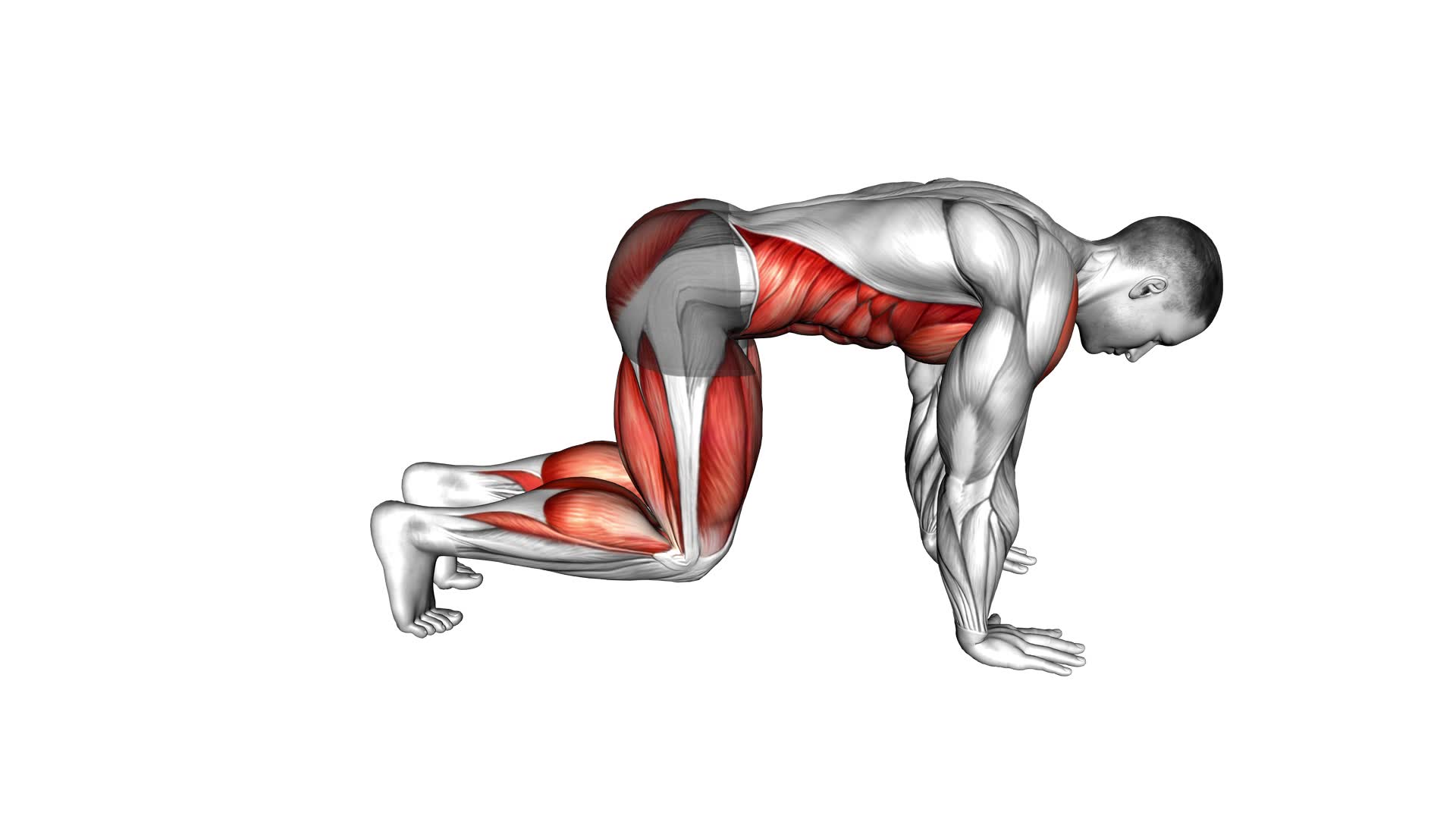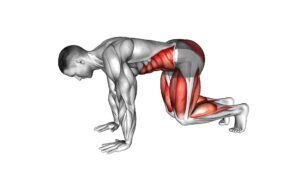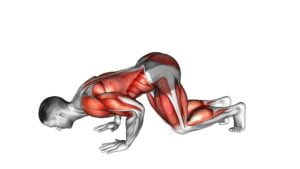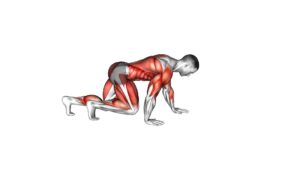Bear Plank Kickback (male) – Video Exercise Guide & Tips

Looking to tone your glutes and strengthen your core? Look no further than the bear plank kickback. This exercise targets multiple muscle groups, helping you achieve a more sculpted physique.
Watch This Exercise Video
In this video exercise guide, we'll show you the proper form and provide helpful tips to maximize your results.
So grab a mat, get ready to sweat, and let's dive into the bear plank kickback for a killer workout!
Key Takeaways
- Bear Plank Kickback targets multiple muscle groups simultaneously, focusing on glutes, hamstrings, and core muscles.
- Proper form and modifications are crucial for performing Bear Plank Kickback effectively and safely.
- Common mistakes to avoid include allowing hips to sag or lift too high, rushing through the movement, and rounding the lower back or hunching the shoulders.
- There are variations and progressions of Bear Plank Kickback that can be incorporated into workouts for added challenge and variety.
Benefits of Bear Plank Kickback
To maximize the effectiveness of your workout, incorporate the benefits of the bear plank kickback into your routine. The bear plank kickback is a compound exercise that targets multiple muscle groups simultaneously. It primarily focuses on the glutes, hamstrings, and core muscles.
During the bear plank kickback, you start in a plank position with your hands directly under your shoulders and your feet hip-width apart. From this position, you lift one leg off the ground and extend it straight back, engaging your glutes and hamstrings. This movement helps to strengthen and tone these muscles, improving your overall lower body strength and stability.
Incorporating the bear plank kickback into a full body workout routine is simple. You can include it as part of your warm-up to activate your glutes and hamstrings before moving on to other exercises. Alternatively, you can incorporate it into your strength training routine, performing multiple sets and reps to challenge your muscles. Remember to maintain proper form throughout the exercise and focus on squeezing your glutes at the top of the movement.
Proper Form for Bear Plank Kickback
Mastering the proper form for the bear plank kickback is crucial for maximizing its effectiveness and ensuring optimal engagement of your targeted muscle groups. Here are some key points to keep in mind:
- Bear plank kickback modifications: If you're a beginner, start by mastering the basic bear plank before attempting the kickback. Once you have the basic plank down, you can progress to adding the kickback motion. Additionally, you can modify the exercise by using resistance bands or ankle weights to increase the intensity.
- Muscle groups targeted in bear plank kickback: The primary muscles targeted in the bear plank kickback are the glutes and hamstrings. This exercise also engages the core muscles, including the abs and lower back. By performing the kickback motion, you activate the glutes even more, making it an excellent exercise for toning and strengthening the lower body.
- Maintain a neutral spine: Throughout the exercise, it's important to keep your spine in a neutral position. Avoid arching or rounding your back to prevent any strain or injuries.
- Control your movements: Focus on maintaining control throughout the exercise. Avoid swinging or using momentum to perform the kickback. Instead, engage your muscles and move in a slow and controlled manner.
Common Mistakes to Avoid
Avoid these common mistakes when performing the bear plank kickback exercise. Proper technique is essential to maximize the effectiveness of this exercise and prevent injury.
One common mistake is allowing your hips to sag or lift too high during the movement. This compromises the stability of your core and reduces the activation of your glutes. Maintain a straight line from your head to your heels throughout the exercise.
Another mistake is rushing through the movement and using momentum instead of controlled muscle contraction. Focus on squeezing your glutes as you extend your leg back, and return to the starting position slowly and under control.
It's also important to avoid rounding your lower back or hunching your shoulders. Keep your spine neutral and engage your core muscles to maintain stability.
By avoiding these technique errors, you can ensure that you're targeting the correct muscles and getting the most out of the bear plank kickback exercise.
Now, let's explore some variations and progressions of this exercise for even greater challenge and results.
Variations and Progressions of Bear Plank Kickback
To challenge yourself further and achieve greater results, you can try different variations and progressions of the bear plank kickback exercise. Here are some options to consider:
- Single-Leg Bear Plank Kickback: Perform the exercise with one leg lifted off the ground, alternating between legs. This variation increases the intensity and targets your glutes and hamstrings more effectively.
- Weighted Bear Plank Kickback: Hold a dumbbell or kettlebell in the working leg's foot for added resistance. This variation helps to build strength and muscle in your glutes and hamstrings.
- Bear Plank Kickback with Resistance Bands: Attach a resistance band around your ankles and perform the exercise as usual. The band creates additional tension, challenging your lower body muscles even more.
- Bear Plank Kickback with Push-Up: Incorporate a push-up into the exercise by performing a push-up after each kickback. This variation engages your upper body muscles, including your chest, shoulders, and triceps, in addition to your core and lower body.
To incorporate the bear plank kickback into a full body workout routine, you can include it as part of a circuit or superset. Pair it with exercises that target other muscle groups, such as squats, lunges, or push-ups, to create a well-rounded workout. Remember to adjust the number of sets and repetitions according to your fitness level and goals.
Tips for Maximizing Results
To optimize your results, follow these simple tips while performing the bear plank kickback exercise.
In addition to the exercise itself, paying attention to your nutrition and recovery strategies can help you maximize your results.
First, let's talk about nutrition tips. To fuel your body for optimal performance and muscle growth, make sure you're consuming enough protein. Protein is essential for muscle repair and growth, so aim to include lean sources of protein in your meals, such as chicken, fish, tofu, or beans. Additionally, don't forget to incorporate a variety of fruits and vegetables for essential vitamins and minerals that support overall health and recovery.
Next, let's discuss recovery strategies. Giving your body enough time to rest and recover is crucial for maximizing results. Make sure to prioritize sleep and aim for 7-9 hours of quality sleep each night. This allows your muscles to repair and grow. Additionally, consider incorporating stretching and foam rolling into your routine to improve flexibility and prevent muscle imbalances.
Frequently Asked Questions
Is the Bear Plank Kickback Suitable for Beginners?
Yes, the bear plank kickback can be suitable for beginners. If you're just starting out, it's important to listen to your body and make modifications as needed.
You can begin by performing the exercise on your knees instead of your toes to decrease the intensity. Additionally, there are alternative exercises for beginners that can help build core strength, such as bird dogs and modified planks.
Remember to start slowly and gradually increase difficulty as you progress.
Can I Do the Bear Plank Kickback if I Have Wrist Problems?
If you have wrist problems, doing the bear plank kickback may not be the best option for you. However, don't worry! There are alternative exercises you can try that won't put too much strain on your wrists.
For example, you could do kneeling kickbacks or standing kickbacks using resistance bands. These modifications will allow you to work your glutes and hamstrings without aggravating your wrist problems.
Remember to always listen to your body and choose exercises that are suitable for you.
How Many Reps and Sets Should I Do for the Bear Plank Kickback?
To get the most out of the bear plank kickback, it's important to focus on proper form and technique.
Start by getting into a bear plank position, with your hands directly under your shoulders and your knees slightly elevated off the ground.
Engage your core and extend one leg back, squeezing your glutes at the top.
Aim for 3 sets of 10-12 reps on each leg.
As you progress, you can increase difficulty by adding ankle weights or using resistance bands.
Is It Necessary to Have Ankle Weights for the Bear Plank Kickback?
No, ankle weights aren't necessary for the bear plank kickback.
There are alternatives you can try to increase the intensity of the exercise, such as using resistance bands or dumbbells.
If you have ankle injuries, there are modifications you can make to still engage your muscles without putting strain on your ankles.
Always consult with a professional or trainer for proper guidance and to avoid further injuries.
Can I Replace the Bear Plank Kickback With Any Other Exercise for Similar Benefits?
If you're looking for alternative exercises to target your glutes and core, there are a few options you can try.
Lunges, glute bridges, and donkey kicks are all great choices. These exercises can provide similar benefits to the bear plank kickback.
Additionally, if you have limited mobility, you can modify the bear plank kickback by performing it on your knees or using a resistance band for added support.
Remember to consult with a fitness professional for personalized advice.
Conclusion
In conclusion, the bear plank kickback is a highly effective exercise for targeting the glutes and core muscles. By maintaining proper form and avoiding common mistakes, you can maximize the benefits of this exercise.
Additionally, incorporating variations and progressions can help to challenge your muscles and keep your workouts interesting.
Remember to follow the tips provided to ensure you get the most out of your bear plank kickback and achieve your fitness goals.

Author
Years ago, the spark of my life’s passion ignited in my mind the moment I stepped into the local gym for the first time. The inaugural bead of perspiration, the initial endeavor, the very first surge of endorphins, and a sense of pride that washed over me post-workout marked the beginning of my deep-seated interest in strength sports, fitness, and sports nutrition. This very curiosity blossomed rapidly into a profound fascination, propelling me to earn a Master’s degree in Physical Education from the Academy of Physical Education in Krakow, followed by a Sports Manager diploma from the Jagiellonian University. My journey of growth led me to gain more specialized qualifications, such as being a certified personal trainer with a focus on sports dietetics, a lifeguard, and an instructor for wellness and corrective gymnastics. Theoretical knowledge paired seamlessly with practical experience, reinforcing my belief that the transformation of individuals under my guidance was also a reflection of my personal growth. This belief holds true even today. Each day, I strive to push the boundaries and explore new realms. These realms gently elevate me to greater heights. The unique combination of passion for my field and the continuous quest for growth fuels my drive to break new ground.







